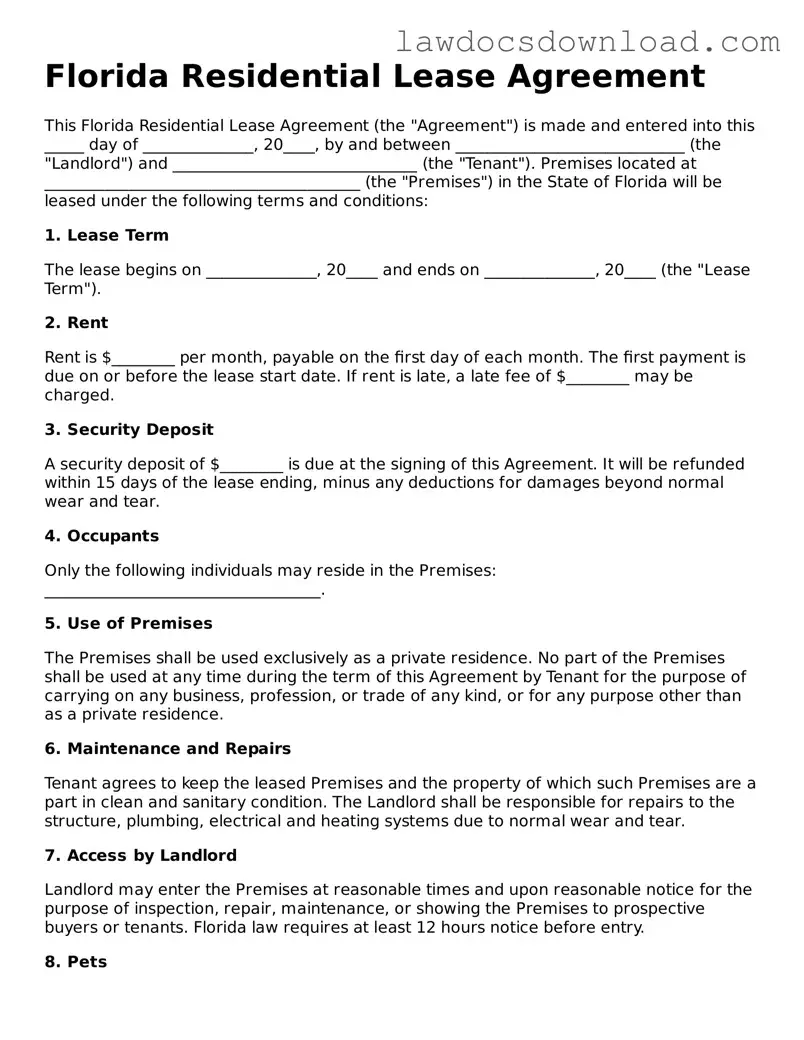The Florida Residential Lease Agreement shares similarities with the Residential Lease Agreement forms utilized in other states. These forms serve as binding contracts between landlords and tenants, delineating the terms under which the tenant can occupy the rental property. They typically outline rent amount, security deposit requirements, lease duration, and conditions for renewal or termination. Although specific legal provisions may vary from one state to another to comply with local laws, the fundamental purpose and structure of residential lease agreements remain consistent across the United States.
Comparable to the Florida Lease Agreement, the Sublease Agreement is a document that outlines the terms under which the original tenant, or sublessor, can rent out their leased premises to a new tenant, or sublessee. Both documents establish a legal relationship between parties regarding the use and occupation of property, but the Sublease Agreement introduces a third party into an existing lease contract. It maintains many of the same conditions as the original lease, yet the original tenant retains certain responsibilities toward the landlord and the sublessee.
The Florida Lease Agreement is also akin to the Commercial Lease Agreement, although they cater to different types of properties. While the Florida Lease Agreement typically pertains to residential properties, the Commercial Lease Agreement is used for renting out business properties, such as offices, warehouses, or retail spaces. Both documents establish terms such as lease duration, rent, security deposits, and maintenance obligations but differ in addressing the specific needs and considerations of commercial versus residential tenancies, like zoning laws and commercial insurance.
Similar to the Lease to Own Agreement, the Florida Lease Agreement sets forth terms under which a tenant occupies a property. However, a Lease to Own Agreement uniquely enables the tenant to purchase the property at the end of the lease term under pre-negotiated conditions. This dual-function agreement acts both as a conventional lease and a purchase agreement, incorporating elements like an option fee, purchase price, and the portion of the rent applied towards the purchase price, which are not found in standard lease agreements.
Rental Application Forms bear resemblance to the Florida Lease Agreement as they are preliminary steps in the leasing process. The application form is used by landlords to screen potential tenants before entering into a lease agreement. It typically requests personal, financial, and rental history information to assess the applicant's eligibility. While the Rental Application Form initiates the tenant selection process, the Lease Agreement formalizes the rental arrangement post-approval.
The Florida Lease Agreement shares common elements with the Roommate Agreement, which is a pact among individuals sharing the same rental premises. The Roommate Agreement outlines individual responsibilities concerning rent, utility payments, chores, and other shared obligations. Though not always a formal requirement, it complements the lease agreement by detailing how roommates will cohabit and share the leased space, ensuring smoother day-to-day operations and mitigating potential disputes.
Eviction Notices, while serving a very different function, relate to the Florida Lease Agreement in the context of lease enforcement and termination. An Eviction Notice is issued by a landlord seeking to remove a tenant from a rental property due to violations of the lease terms, such as non-payment of rent or other breaches. This document follows the lease agreement as it executes its enforcement mechanism, highlighting the legal steps necessary for eviction under the governing rental laws.
The Florida Lease Agreement is paralleled by the Property Management Agreement, which delineates the relationship between property owners and the managers they employ to oversee their rental properties. This agreement specifies the manager's responsibilities, including finding tenants, collecting rent, and maintaining the property. Although focusing on the management aspect, both documents are pivotal to the rental operation's success, ensuring properties are rented under agreed terms and well-maintained.
Much like the Lease Amendment, which serves to modify terms of an existing lease agreement, the Florida Lease Agreement establishes the initial terms of occupancy. The Lease Amendment allows both parties to make changes to the lease after it has been executed, such as altering the rent amount, extending the lease term, or adding new provisions. Both documents are integral to managing and adjusting the legal relationship between landlords and tenants as circumstances change.
Last but not least, the Move-In/Move-Out Checklist is closely connected to the leasing process, offering a practical tool for documenting the condition of the rental property at the beginning and end of the tenancy. While it does not define the terms of the lease, it complements the Florida Lease Agreement by creating a benchmark for evaluating the property's state, which is crucial for addressing security deposit deductions and ensuring maintenance standards are met.
